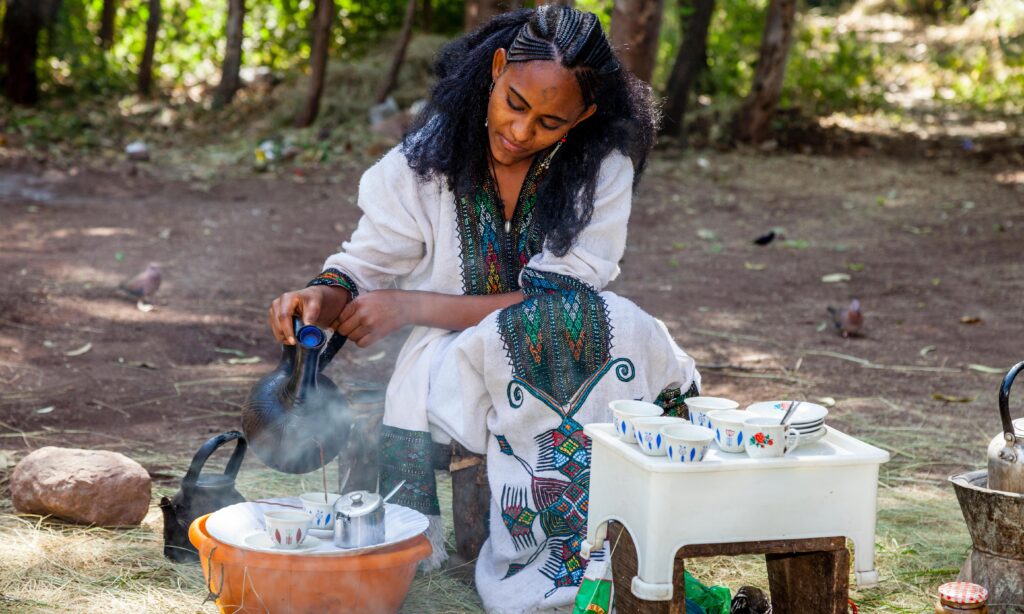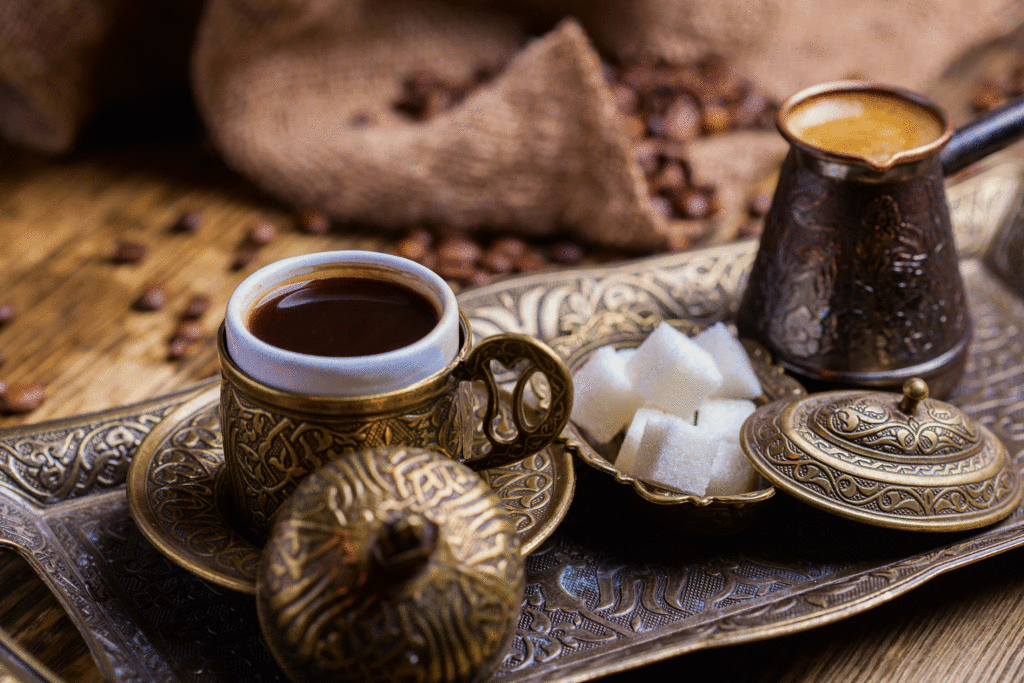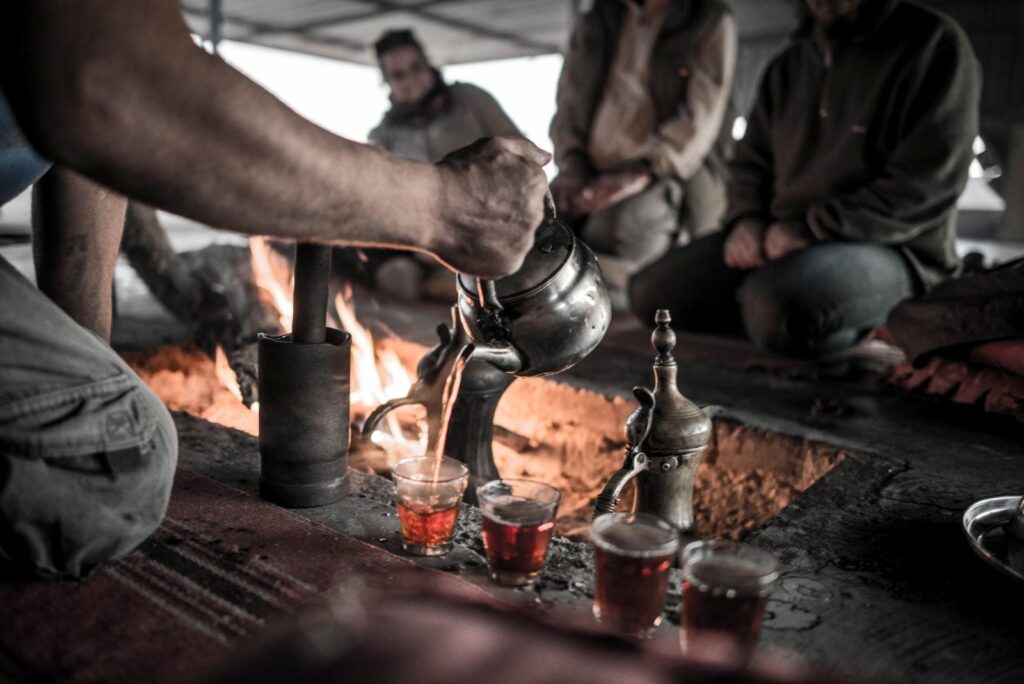Coffee Rituals Around the World: A Cultural Journey Through Brews!
Coffee, beyond being a delightful beverage, holds a special place in cultures coffee rituals worldwide. It’s not just a drink; it’s a ritual that brings people together, reflects traditions, and offers a unique lens into the diverse tapestry of global societies. In this exploration, we embark on a captivating journey to discover the fascinating coffee rituals from different corners of the world. From intricate preparation methods to the social significance of sharing a cup, let’s delve into the rich cultural aspects that make each coffee experience truly exceptional.

Ceremonies around the World!
The Ethiopian Coffee Ceremony: A Cultural Celebration of Flavour and Togetherness.
1. Ethiopian Coffee Ceremony: Sharing Stories over Freshly Roasted Beans in Ethiopia, coffee isn’t just about caffeine – it’s a symbol of hospitality, friendship, and community. The elaborate Ethiopian coffee rituals or ceremony involves roasting green coffee beans, grinding them, and brewing in a traditional pot called a “jebena.” The aroma of roasting beans fills the air as participants gather, share stories, and connect over the freshly brewed coffee, emphasizing the importance of togetherness.

Introduction: Step into the vibrant world of Ethiopian culture, where coffee isn’t just a beverage, but a treasured tradition that unites families, friends, and communities. The Ethiopian coffee ceremony is a remarkable cultural practice that goes beyond brewing coffee; it’s a symbol of hospitality, storytelling, and deep-rooted connections. In this article, we’ll delve into the intricate details of the Ethiopian coffee ceremony, its various elements, the types of coffee used, and the frequency with which it’s celebrated.
The Ethiopian coffee rituals or ceremony is a ritual that involves several stages, transforming the simple act of brewing coffee into a social and sensory experience. Here’s a breakdown of what it involves:
- Roasting: The ceremony typically begins with the roasting of green coffee beans over an open flame. The scent of roasting coffee fills the air, inviting neighbors and guests to join in.
- Grinding: Once the beans are roasted to perfection, they’re ground using a traditional mortar and pestle, producing coarse coffee grounds that are essential for the brewing process.
- Brewing: The ground coffee is then placed in a special vessel called a “jebena.” Water is added, and the mixture is gently heated until it reaches a near-boil. This careful process brings out the nuanced flavors and aromas of the coffee.
- Pouring and Serving: The host pours the freshly brewed coffee from the jebena into small cups, often from a height to create a frothy layer known as the “buna silt.” These cups are then handed out to guests as a symbol of hospitality and respect.
- Enjoying and Socializing: Guests are encouraged to savor the coffee while engaging in conversations, storytelling, and building connections. The Ethiopian coffee ceremony emphasizes the importance of togetherness and shared moments.
Types of Coffee Used: In Ethiopia, two main types of coffee are commonly used in the ceremony:
- Bunna (Coffee Arabica): This is the traditional coffee variety used in the ceremony. Its delicate flavors and floral aromas are brought to life through the meticulous preparation process.
- Bunna Bishuftu (Coffee Liberica): Less common but equally cherished, this coffee variety offers a distinct and slightly fruity flavor profile, contributing to the diversity of the Ethiopian coffee experience.
Frequency of the Ceremony: The Ethiopian coffee ceremony is an integral part of daily life in Ethiopian households. It’s not just reserved for special occasions; it’s a regular practice that signifies hospitality, friendship, and community bonds. It’s common to find families, friends, and neighbors gathering for the ceremony multiple times a day.
Conclusion: The Ethiopian coffee rituals or ceremony is more than a brewing method; it’s a cultural journey that celebrates the art of coffee preparation, storytelling, and human connections. With each step, from roasting to sharing, the ceremony showcases the profound impact that a cup of coffee can have on fostering relationships and preserving traditions. So, the next time you savor a cup of Ethiopian coffee, remember the rich heritage and meaningful rituals that make every sip a tribute to togetherness and coffee rituals encompassed within.
Italian Espresso Culture: The Heartbeat of Societal Connection and Culinary Artistry.
2. Italian Espresso Culture: The Art of Quick Savouring Italy’s espresso culture showcases the elegance of simplicity. From standing at a bustling espresso bar to swiftly sipping a shot, Italians have turned coffee into an art form. Discover how Italians use espresso not only as a caffeine boost but also as a way to pause, socialize, and appreciate life’s fleeting moments.

Step into the vibrant streets of Italy, where every corner café echoes with the rich symphony of hissing steam, clinking cups, and lively conversations. Italian espresso culture isn’t just about a quick caffeine fix; it’s a way of life that embodies the art of savoring and the essence of community. In this article, we’ll explore the origins of Italian espresso culture, its profound significance in Italian society, the frequency of its consumption, and the favored espresso varieties that make this culture truly iconic.
Origins and Significance of Italian Espresso Culture: The roots of Italian espresso culture trace back to the early 20th century, with the invention of the espresso machine in Turin. This innovation revolutionized coffee consumption, allowing for the rapid extraction of concentrated coffee shots. Over the decades, the culture evolved to become a cherished part of Italian identity, emphasizing the art of quick savoring, social interaction, and appreciation for life’s simplest pleasures.
The Essence of Espresso in Italian Society: Italian espresso culture is deeply intertwined with the fabric of everyday life. It’s a cornerstone of social gatherings, business meetings, and personal moments of reflection. The coffee bar, or “caffè,” is more than just a place to grab a drink; it’s a communal space where people come together to engage in conversations, share experiences, and celebrate both small victories and profound moments.
Frequency of Espresso Consumption: In Italy, espresso is not just a morning ritual; it’s a multi-faceted experience enjoyed throughout the day. Italians typically start their day with a quick shot of espresso, but it doesn’t stop there. Espresso is often consumed after meals to aid digestion and is a popular choice for breaks in between work or errands. This frequency of consumption speaks to the integral role that espresso plays in keeping Italians connected and energized.
Favorite Espresso Varieties in Italy: While there are various espresso varieties, two stand out as favorites in Italy:
- Caffè Normale (Short Espresso): This classic shot is the foundation of Italian espresso culture. It’s a concentrated shot of rich, bold coffee with a layer of crema on top, offering a powerful burst of flavor in a small sip.
- Caffè Lungo (Long Espresso): For those who prefer a milder taste, the caffè lungo is an extended version of the traditional espresso, where more water is allowed to pass through the coffee grounds. This results in a larger cup with a smoother profile.
Conclusion: Italian espresso coffee rituals and culture is a testament to the Italians’ dedication to savoring life’s moments and fostering connections. It’s not just about the coffee; it’s about the experience of sharing a drink, engaging in conversations, and being part of a larger community. As you sip your own cup of espresso, take a moment to appreciate the centuries-old tradition that continues to shape Italian society and remind us all of the beauty in the everyday rituals that bring us together.
Turkish Coffee Culture: A Journey Through Tradition, Ritual, and Flavour.
3. Turkish Coffee: Fortunes in Every Sip in Turkey, coffee is a symbol of tradition and spirituality. The preparation involves boiling finely ground coffee, water, and sugar in a special pot. What makes it unique is the tradition of fortune-telling from the coffee grounds left in the cup. Explore the mystique surrounding Turkish coffee and its role in social interactions, from weddings to casual gatherings.

In the heart of Turkey, a timeless ritual unfolds – the Turkish coffee ceremony. Beyond its rich taste and invigorating aroma, Turkish coffee holds a special place in the culture, representing hospitality, tradition, and a deep connection to the past. In this blog post, we’ll delve into the enchanting world of Turkish coffee culture, explore its various types, understand the frequency of its consumption, and uncover the profound significance of the Turkish coffee ceremonies.
Unveiling Turkish Coffee Culture: A Blend of Past and Present: Turkish coffee isn’t merely a beverage; it’s a cultural tradition that dates back centuries. Introduced to Turkey in the 16th century, it quickly became an integral part of daily life. Today, Turkish coffee stands as a bridge between generations, embodying the essence of Turkish hospitality, shared moments, and storytelling.
The Art of Preparation and Presentation: Turkish Coffee Ceremonies: The Turkish coffee ceremony is a meticulously choreographed performance that showcases the cultural significance of coffee. Here’s a glimpse into its key elements:
- Grinding and Brewing: The coffee beans are ground into an ultra-fine powder, transforming the coffee into a potent elixir. The ground coffee is then combined with water and sugar in a special pot known as a “cezve.”
- Heating and Frothing: The cezve is heated gently over low flames. As the coffee heats, it froths up, forming a layer of foam known as “kaymak.” The froth is an essential element in the coffee’s flavor and presentation.
- Serving: The coffee is poured into small cups, and its grounds are allowed to settle. Traditionally, the cup is filled only two-thirds to allow space for the grounds.
- Fortune-Telling: After sipping the coffee, the cup is turned upside down onto a saucer to cool. Once cooled, the cup is examined, and fortune-telling is performed based on the patterns left by the grounds.
Varieties of Turkish Coffee: From Sade to Şekerli: Turkish coffee comes in different variations to suit varying preferences:
- Sade (Plain): Unsweetened Turkish coffee, enjoyed by those who prefer the pure taste of coffee.
- Az Şekerli (Little Sugar): Coffee with a hint of sweetness, perfect for those who enjoy a touch of sugar without overwhelming the coffee’s flavor.
- Orta (Medium Sugar): A balanced blend of coffee and sweetness that appeals to a wide range of tastes.
- Şekerli (Sweet): Richly sweetened coffee, offering a delightful contrast to the coffee’s bitterness.
Frequency and Significance: A Ritual Woven into Everyday Life: The Turkish coffee ceremony isn’t limited to special occasions – it’s a daily tradition. It’s a way to welcome guests, bond with family, and strengthen friendships. The ceremony symbolizes unity, connection, and the passing down of cultural heritage from one generation to the next.
Conclusion: Turkish coffee culture isn’t just about enjoying a cup of coffee; it’s about embracing tradition, sharing stories, and fostering relationships. From the preparation ritual to the meaningful fortune-telling, Turkish coffee is a journey that transports us to a time where every sip was an opportunity to connect with others and create lasting memories. As you savor a cup of Turkish coffee, remember that you’re partaking in a cultural legacy that spans centuries – a testament to the enduring power of tradition and the magic of human connection.
Japanese Slow-Drip Coffee: A Delicate Art Form Weaving Tradition and Precision.
4. Japanese Slow-Drip Coffee: Patience and Precision Japan’s meticulous approach to coffee is reflected in its slow-drip brewing method. The intricate process involves precisely controlling water flow over coffee grounds to create a smooth, nuanced cup. These ritual showcases Japan’s dedication to craftsmanship and attention to detail with its own coffee ritual, resulting in a uniquely refined coffee experience.

In the heart of Japan’s refined culture lies an intricate and methodical coffee ritual preparation technique known as Japanese slow-drip coffee. This captivating method is more than just a way to brew a cup of coffee; it’s a harmonious blend of patience, precision, and elegance that reflects the very essence of Japanese tradition. In this blog post, we’ll delve into the profound significance of Japanese slow-drip coffee ritual, explore its meticulous process, and discover the types of coffees that make this brewing method truly exceptional.
Japanese Slow-Drip Coffee: A Sublime Expression of Culture: Japanese slow-drip coffee, or “siphon coffee” as it’s sometimes called, goes beyond the realm of a mere beverage. It’s an artful ritual that encapsulates Japan’s commitment to craftsmanship, attention to detail, and the pursuit of perfection. This brewing technique reflects the Japanese philosophy of “wabi-sabi,” valuing the beauty in imperfection and embracing the process as much as the result.
The Methodical Brewing Process: A Symphony of Precision: The slow-drip coffee process involves a beautifully designed apparatus known as a “siphon” or “vacuum pot.” Here’s a step-by-step breakdown of how Japanese slow-drip coffee is made:
- Water Heating: The siphon’s bottom chamber is filled with water, which is then heated. As the water heats, it creates pressure, pushing it into the upper chamber.
- Coffee Grounds and Infusion: While the water rises, coffee grounds are placed in the upper chamber. The hot water infusion begins as the two chambers connect, creating a vacuum that draws the water upward.
- Brewing Time: The coffee and water interact within the upper chamber, allowing the flavors to meld over a prolonged period. The slow extraction process results in a rich, nuanced coffee.
- Filtering and Extraction: Once the brewing is complete, the heat is removed, and the brewed coffee is drawn back into the lower chamber, passing through a filter that ensures a clean cup of coffee.
Types of Coffee Used in Japanese Slow-Drip Brewing: Japanese slow-drip coffee highlights the subtle intricacies of various coffee beans. While the method itself can be applied to different beans, some types are particularly well-suited to this brewing technique:
- Single-Origin Coffees: The slow-drip process accentuates the unique characteristics of single-origin coffees, allowing the drinker to explore the distinct flavors of different coffee-growing regions.
- Light to Medium Roasts: The method’s gentle extraction process is ideal for lighter and medium roasted beans, preserving delicate flavors and aromatic notes.
The Significance of Slow-Drip Coffee in Japanese Culture: Japanese slow-drip coffee extends beyond the mere act of brewing; it embodies patience, mindfulness, and a celebration of the present moment. The slow and deliberate preparation mirrors Japan’s affinity for precision in various artistic and culinary pursuits. The act of serving slow-drip coffee becomes an offering of care and attention, fostering connections between the brewer and the drinker.
Conclusion: Japanese slow-drip coffee ritual is a journey of meticulous craftsmanship and contemplative enjoyment. It’s a reminder that in a fast-paced world, taking the time to savor a cup of coffee can be an experience that enriches both the senses and the soul. As you explore the world of Japanese slow-drip coffee, remember that you’re participating in a tradition that weaves together history, culture, and a deep reverence for the art of brewing.
Bedouin Coffee Tradition: A Cultural Tapestry Woven with Hospitality and Heritage.
5. Bedouin Coffee Tradition: Symbol of Hospitality in the Desert In the heart of the Arabian desert, Bedouin coffee represents warmth and generosity. Guests are welcomed with a small cup of strong, cardamom-flavoured coffee, often served in three rounds. Each round has a specific meaning, from bitterness to strength, reflecting the journey of life. Explore how this tradition emphasizes community bonds and the importance of offering hospitality to strangers.

In the vast stretches of the Arabian desert, the Bedouin coffee tradition weaves a tapestry of warmth, hospitality, and tradition. This age-old practice, rooted in the sands of time, offers more than just a cup of coffee – it symbolizes a way of life, a connection to the land, and a profound reverence for community. In this article, we’ll delve into the enduring significance of the Bedouin coffee tradition, uncover its rich history, explore the art of its preparation, and discover the unique blend of coffee that holds this tradition together.
A Journey Through Time: The Ancient Roots of the Bedouin Coffee Tradition: The Bedouin coffee tradition traces its origins back to the nomadic Arab tribes that have roamed the desert for centuries. It’s a tradition deeply embedded in the lifestyle and identity of the Bedouin people. This practice isn’t merely a beverage; it’s a symbol of welcome, friendship, and the sacred act of sharing stories in the heart of the desert’s vastness a tradition of coffee rituals I have experienced.
Preparing the Coffee: A Ritual of Togetherness: The Bedouin coffee-making process involves an artful ritual that epitomizes hospitality. Here’s a glimpse into its core components:
- Roasting and Grinding: Fresh green coffee beans are carefully roasted over an open flame. Once roasted, the beans are ground to a fine powder, releasing the captivating aroma that fills the air.
- Boiling and Brewing: The finely ground coffee is then boiled in a special pot known as a “dallah.” Water is added along with spices like cardamom, imparting a unique flavor to the brew.
- Serving and Symbolism: The coffee is poured into small cups, usually no larger than a few sips. It’s customary to serve three rounds of coffee, each with a distinct meaning – the first is “bitter like life,” the second is “gentle like love,” and the third is “sweet like death.” This progression reflects the journey of life itself.
The Blend of Coffee: A Blend of Tradition and Taste: The coffee used in the Bedouin coffee tradition is typically Arabica coffee beans, which offer a smooth and nuanced flavor profile. However, it’s the addition of spices, particularly cardamom, that gives Bedouin coffee its distinctive character. The infusion of cardamom adds an aromatic depth that pairs harmoniously with the coffee’s natural richness.
History and Cultural Significance: Connecting Through the Sands of Time: The Bedouin coffee tradition holds deep cultural significance. It’s not just about serving a beverage; it’s about sharing a moment, creating bonds, and embracing strangers as friends. For the Bedouin people, coffee symbolizes unity, and the act of preparing and serving it is a gesture of goodwill that transcends language and cultural barriers.
Conclusion: The Bedouin coffee rituals tradition stands as a testament to the endurance of cultural practices and their ability to forge connections across generations. As you sip a cup of Bedouin coffee, remember that you’re participating in a tradition that has united travellers, tribes, and strangers under the vast desert sky for centuries. It’s a celebration of humanity’s shared experiences and the magic that happens when we extend a cup of warmth and hospitality to one another.
Conclusion:
These coffee rituals are windows into the souls of cultures across the globe. They reveal the profound impact a simple cup of coffee can have on forging connections, preserving traditions, and celebrating life’s moments. As we traverse the diverse landscapes of coffee culture, we come to appreciate how a single beverage can encapsulate the essence of humanity’s shared experiences. So, next time you sip your coffee, remember that it’s more than just a drink – it’s a bridge that connects us to people, stories, and traditions from around the world.
Author.
Brendon McAliece is a multi lingual-expat who brings over three decades of flight simulator/PC building experience as well as over two decades of real world jet fighter experience as a weapons/egress technician. He holds a sport pilot certificate giving him real world flying experience. Hi travels have taken him from Europe to the Middle East, Asia and his home of Australia. He has a passion for travel, languages, Flight simulation as well as Guitaring and Coffee. You can read more in his blogs below.
Learn more @
DreamingGuitar.com – DreamingCoffee.com – LetsFlyVFR.com
Home – Blog – Shop – About
As an Amazon affiliate I may earn on qualifying sales.










13 responses to “Coffee Rituals Around the World: A Cultural Journey Through Brews!”
[…] and Flavour Preservation: Coffee carafes create a controlled environment that helps preserve the flavours and aromas of your coffee for a longer duration. The airtight seals and heat insulation prevent […]
[…] involves more than just brewing—it’s an exploration of textures, aromas, and memories. A cup of coffee infused with the essence of vanilla, paired with delightful coffee and vanilla-infused creations, […]
[…] uncovering how they intertwine with personal moments, social interactions, and the art of savouring life’s little pleasures. So, grab your favourite mug and embark on a journey through the myriad flavours and stories that […]
[…] a delightful concoction of smooth espresso, whipped cream, and a touch of history, has delighted coffee enthusiasts for centuries. This beloved coffee drink traces its origins back to the vibrant cultural hub of Vienna, Austria. […]
[…] acid and caffeine. Another study, published in the journal Nutrients in 2018, found that coffee consumption was associated with lower levels of inflammatory markers in the […]
[…] popularity of coffee gradually spread to the Arabian Peninsula, where it became an important part of Islamic culture. By the 15th century, coffee was being […]
[…] or cold milk. The drink’s distinctive layered look and ease of preparation made it a hit with people around the world, who were spending more time at home due to lockdowns and social distancing […]
[…] Finally, the aroma of your coffee can tell you a lot about its quality. Freshly brewed coffee should have a strong, pleasant aroma that is indicative of the coffee’s flavour profile. If […]
[…] on the other hand, is made by freeze-drying or spray-drying brewed coffee. The process involves brewing coffee as usual, then removing the water from the brewed coffee through a process of evaporation or freeze-drying. […]
[…] culture has become an essential part of daily life for many people around the world, and it has given rise to various coffee beverages. Three of the […]
[…] coffee is a traditional method of preparing and serving coffee that has a rich history and is deeply rooted in the culture of countries like Turkey, Greece, and […]
[…] coffee is one of the most common methods of brewing coffee. It involves pouring hot water over ground coffee beans placed in a paper or metal filter, which […]
[…] is a beloved beverage enjoyed by millions of people worldwide, and it’s no surprise that there are plenty of coffee FAQ about this […]